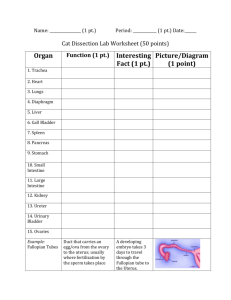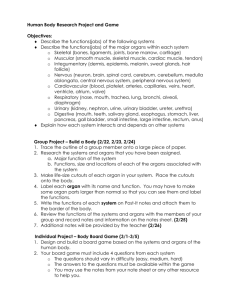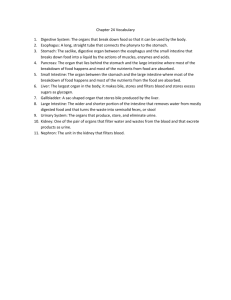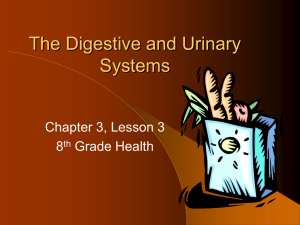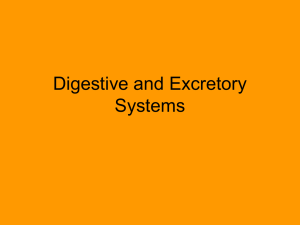Digestive System Organs
advertisement
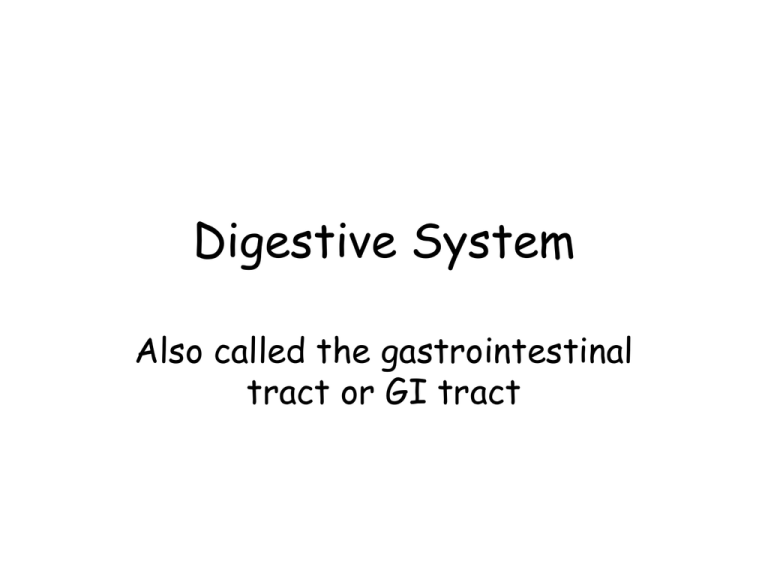
Digestive System Also called the gastrointestinal tract or GI tract Main Function: to convert food into simpler molecules that can be absorbed by the body. Salivary Gland Mouth Esophagus Stomach Large Intestine Anus Small Intestine Rectum Digestive System Organs (in the order that food travels) Part Function & Enzymes / Secretions Involved Mouth Mechanical Digestion: teeth breaks down food into smaller units to be swallowed Chemical Digestion: saliva has enzymes to break down sugars Esophagus Flat muscular tube that connect the pharynx with the stomach. Wave-like muscular contractions, called peristalsis, push the food downward from the mouth to the stomach. Stomach Muscular sac that begins the chemical digestion of food by the secretion of hydrochloric acid and other enzymes. Small Intestine Most digestion and absorption of nutrients occurs here. It absorbs the nutrients into the bloodstream. Have finger-like projections, called villi, that line the walls to increase surface area for absorption. (“Small” due to diameter/not length; it is longer than the large intestine) Large Intestine Rectum Also called the colon. (“Large” due to diameter/not length) Absorbs water into the bloodstream to form solid feces. Last straight part of the intestine in which feces (undigested waste material) passes out of the body through an opening called the anus. Other Organs Involved in Digestion: 1. Pancreas – organ which makes digestive fluids and the hormone called insulin. 2. Liver – largest internal organ that makes bile, which is a green liquid that digests fats; stores excess glucose 3. Gallbladder – small sac that stores bile. Liver Gallbladder Pancreas Excretory System Main Function: to remove metabolic wastes from the bloodstream. Metabolic wastes include excess salt, water, carbon dioxide, and urea. Excretory System Organs Organ Function Kidneys Filters the blood to remove metabolic wastes to form urine. The kidneys are two bean-shaped organs, one located on either side of the spinal column near the lower back. Each one is about the size of a tightly clenched fist. Ureters Two tubes that carry urine from the two kidneys to the urinary bladder Urinary Stores urine until it exits the body. Bladder Urethra Tube in which urine exits the body from the urinary bladder Excretory System Organs Adrenal Gland Kidney Ureters Urinary Bladder Urethra Other Organs of Excretion Lungs Removes _CO2 and water vapor___from the body Skin Removes excess water, and salt in the form of ___sweat_______. Control of Kidney Function What is ADH? – Antidiuretic Hormone. It is secreted from the pituitary gland. Actions of ADH as a Feedback Mechanism. Increases amount of water in blood and decreases amount of urine produced. Tells pituitary that amount of water in blood is low. Tells pituitary that amount of water in blood is high. Releases ADH into bloodstream. Stops releasing ADH into bloodstream Reabsorb more water. Reabsorbs less water. Decreases amount of water in blood and increases amount of urine produced.


